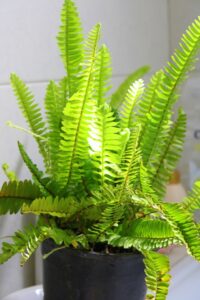Some links in the post are affiliate links and I get a commission from purchases made through some links found in the post.
Among the popular houseplants you will find the Boston fern. Its correct name is Nephrolepis exaltata and you may also know it as the sword fern.
This popular houseplant grows in tropical climates all around the world and while it is not a high maintenance plant, there are some specific needs for it to thrive.
Now you may have already started to feel that this house plant is not suited to you because the thought of ‘specific needs’ but in truth this is not a complicated houseplant to have.
Boston ferns are evergreen with sword-shaped fronds from which you see many tiny leaves growing. It is a slow grower and enjoys warm, humid conditions.
There are some things that will upset the plant environment such as temperature extremes and draughts. They do not like being placed near heating vents and air conditioners.
You may need to adjust your own schedule to make sure that the plant gets enough water, yet not too much so that it is boggy.
The ideal humidity for a Boston fern is between 50% to 60% humidity but they can also thrive in levels up to and above 80% humidity.
Unless you live in a humid area, a good misting will help to keep conditions just right or a tray filled with water and pebbles.
You may need to keep an eye on the humidity as the ideal humidity level for your home is 40%-60%.
Now with this in mind we’ll move on to how to keep your Boston fern happy because a truly happy Boston fern is a wonderful plant – beautiful enough to grace any home all year round.
What is the Ideal Humidity for a Boston Fern?
This plant loves humidity and high humidity is crucial to the well-being of the plant.
As said before the ideal humidity for a Boston fern is between 50% to 60% but levels of higher than 80% humidity are exactly what your Boston fern loves as well.
Later on we go over how to achieve this to keep your Boston fern happy and thriving.
How to Find out What Humidity your Home is
The easiest way to check the humidity in a house is to use a hygrometer. You can buy these online or even at a reputable garden centre.
This device will show you the inside temperatures and the humidity. It will also monitor the interior humidity for you.
The ice cube method
 If you do not have a hygrometer this is another way to find out the humidity in your home.
If you do not have a hygrometer this is another way to find out the humidity in your home.
You will need a glass of water and a handful of ice cubes. Make sure that the water is at room temperature and not too hot or icy cold from the fridge as both of these will mess up the results.
Fill the glass with water and place two or three ice cubes in it. Set your timer for four minutes and then look at the water.
If the outside of the glass has condensation dripping down the sides then your humidity levels are high.
If there is no condensation running down the outside of the glass then the humidity level is low.
With this method it is important that you are out of the kitchen because the heat from cooking can be an influence on the ice cubes and you will not have an accurate result. Best to leave the glass in a room that is unoccupied for that time.
Wet and dry bulb thermometer test
This humidity test is far more accurate that the ice cube method. You will need two regular bulb thermometers.
Take the first thermometer and wrap a moistened cotton ball around the end (the bulb part). Secure this with a small rubber band to keep it intact. This is the wet bulb.
Now set both thermometers side-by-side on a piece of cardboard and leave them for six minutes.
Check the results of both thermometers and write them down. Subtract the result of the wet bulb from the dry bulb and this will give you the depression value.
Once you have this you will be able to check online and compare them to a ‘relative humidity’ chart.
How can we Increase the Humidity in the Home?
Ideally your home should be around 45% humidity. Dropping much below 30% means it is far too dry. Above 50% says that it is overly humid, and you may start to feel uncomfortable and sweaty.
For a healthier, cleaner living environment you should aim to keep the humidity levels around 45%. This will also make you feel more comfortable.
How to increase the humidity?
- Install a humidifier
- Use houseplants to increase humidity
- Boil a pot of water on the hob
- Instead of tumble drying, let clothing hang dry
- Leave the bathwater in until it goes cold
- Place a pot or vase of water in a room
- Leave the bathroom door ajar when you shower
You may also like: What are the benefits of a Boston fern
What are the Signs on your Boston Fern that the Humidity is not Right?
Because this plant is native to tropical regions, it does not do well unless we replicate them as best we can.
Signs that your Boston fern is not doing well are:
- Brown, dry leaf tips
- Leaves which turn yellow
- Leaves which drop off for no reason
For a Boston fern to do well the humidity needs to be high, that’s the bottom line with this plant. It will thank you profusely if the area around it is above 80% humidity.
Now while this may not be suitable for your home, you can recreate the conditions in that small area.
Set your plant on a tray which is filled with pebbles and water. Make sure that there is always water in the saucer. Another method is to mist the fern frequently.
Do Boston Ferns Help with Humidity?
In fact, Boston ferns can help absorb a certain amount of moisture from the air.
They can tolerate either moist environment or lower humidity, although they prefer higher levels. They are better suited to indirect light rather than direct light or shade.
Can Boston Ferns get too Much Humidity?
Ideally the Boston fern prefers up to 80% humidity which is far more than what is found in most homes. Its natural habitat is in the tropical climates where it is incredibly humid. Without high humidity they can suffer and look unhealthy.
While too much humidity may eventually harm a Boston fern, it is unlikely that they will ever get that level of humidity in a home as it would be more uncomfortable for us than it would for the plant.
You may also like: Boston fern light requirements
Do Boston Ferns like to be Misted?
Yes, Boston ferns enjoy being misted. In fact, anything you can do to improve the humidity conditions around your fern will reward you with gleaming fronds.
Misting your Boston fern is a very easy and cheap way to improve the conditions. Misters are inexpensive and can be left filled with water so that misting becomes a habit for you. Indeed, your Boston fern will thank you for this!
How to Mist a Boston Fern
 Ideally you should mist your Boston fern in the morning. However, there is nothing to stop you misting at any other time of day.
Ideally you should mist your Boston fern in the morning. However, there is nothing to stop you misting at any other time of day.
If you keep a spray bottle filled up near the plant you can give it a spray every time you pass it. The idea is to keep the air around the fern moist but not let the roots become boggy.
Take your time and try to cover as many fronds as you can when you spray the plant.
However, do not have the water accumulate on the soil in puddles. It is better to water well and be sure that all excess water drains away than to have standing water as this may cause root rot.
Is a Boston Fern Suitable for the Bathroom?
Because of its origins in the tropics, Boston ferns are perfectly suited to bathrooms where it is very likely to be more humid than any other room in the house.
Additionally, because they do not like direct light they work well I bathrooms where there are normally only small windows and very little direct light.
Care should be taken that they do receive some indirect light, otherwise the growth will be stunted, and the plant may turn yellow.
Another reason for placing a Boston fern in the bathroom is that they look simply stunning against any white units and backsplashes.
Just adding a fern to a shelf in the bathroom gives a sophisticated and elegant appearance to an otherwise dull bathroom.
If you’re enjoying this article, check out our article on how to stop your Boston fern leaves curling.
Where are Suitable Places to put a Boston Fern?
Boston ferns can take a small amount of direct sunlight as long as it is in the early morning when the sun’s rays are not too harsh, so if you have a place in mind, other than the bathroom, bear this in mind.
Wherever you place your fern remember that as conditions change through the year you may have to move your plant somewhere better.
Ideally the Boston fern will be fine in a south or north facing window. In east or west facing windows you will need to place them a few feet away from the light to avoid the leaves getting burned.
If you plan on using a Boston fern in a hanging basket then try to hang it a few feet away from the window so that it is out of direct light through the day, and also not in any draughts or updrafts from wall heaters.
Another consideration for placing your Boston fern in a good spot is keeping it away from draughty doors and heating vents as both these will leave you with an unhappy plant. The soil will dry out so you should check frequently for moisture.
When Can I put my Boston Fern Outside?
For the Boston fern to grow well it needs temperatures no higher than 75 degrees in the day and 65 degrees during the night.
If you live in an area where the day temperatures rocket upwards of the nineties, then your plant simply will not survive outside, even if you move it to a shady spot.
If you really must place your plant outdoors, you need a cool sheltered spot where it is never this hot. A combination of sky-high temperatures and humidity do not make for a healthy Boston fern.
What are the Benefits of Maintaining Humidity in the Home?
There are very definite reasons to keep the humidity in your home a little higher, particularly in the winter months.
Control the dust better
Having an ideal humidity level will help to control dust and allergens. It will also help keep pollutants out of the air, which will make it cleaner and easier to breathe.
Helps prevent common illnesses
Transmittable viruses like the common cold and the flu are spread easier in dry air. Better humidity levels also help stop sore throats and headaches. For people who wear contact lenses, the higher humidity makes wearing lenses much more comfortable.
Better skin hydration
Moist skin is less likely to succumb to dryness and irritation and is less likely to crack.
Reduces shocks
Have you ever noticed how, in winter, things you touch seem you give you a slight shock? With a better humidity level this will not happen.
Furniture
If you or anyone else has real wooden furniture you will notice that in hot weather the wood develops small cracks and can even warp.
In more humid conditions the wood is kept moist and warping or cracking is less likely to take place. This is especially important for pieces of furniture like pianos and hardwood floors which may even start to buckle.
Final Thoughts
 Just because the Boston fern needs higher humidity than many other plants there is no reason why you should not have one.
Just because the Boston fern needs higher humidity than many other plants there is no reason why you should not have one.
These are not difficult plants to maintain, and once you have mastered the conditions which keep them happy, you will be rewarded with a magnificent fern which can grace any area or bathroom with its beauty.
Increasing the humidity in your home will also be beneficial to you, particularly if you or a family member has respiratory issues as moist air will control the dust and help prevent cold viruses.
While you need to take care if you plant your Boston fern outdoors, in the right climate and in the right spot, whether in a pot or a hanging basket, this plant is one that will always be admired.
Before you go, here are some more related articles I encourage you to read below to help solve more of your gardening issues:
How To Save A Dying Staghorn Fern
How to Grow Asparagus Ferns from Tubers
Why Does Your Fern Smell Like Fish and How to Fix it
Can I Grow Ferns in Water Only


